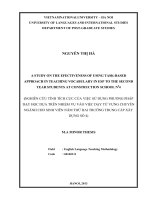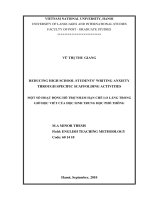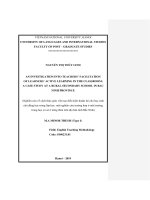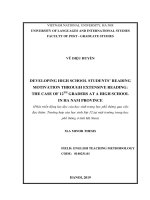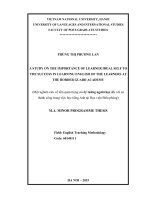Luận văn thạc sĩ EFL high school teachers perceptions of using information and communication technology (ICT) in their teaching
Bạn đang xem bản rút gọn của tài liệu. Xem và tải ngay bản đầy đủ của tài liệu tại đây (1.99 MB, 91 trang )
MINISTRY OF EDUCATION AND TRAINING
QUY NHON UNIVERSITY
NGUYỄN THỊ THU PHƢƠNG
EFL HIGH SCHOOL TEACHERS’ PERCEPTIONS
OF USING INFORMATION AND COMMUNICATION
TECHNOLOGY (ICT) IN THEIR TEACHING
Field: Theory and Methodology of English Language Teaching
Code: 8140111
SUPERVISOR : LÊ NHÂN THÀNH, Ph.D
BỘ GIÁO DỤC- ĐÀO TẠO
TRƢỜNG ĐẠI HỌC QUY NHƠN
NGUYỄN THỊ THU PHƢƠNG
NHẬN THỨC CỦA GIÁO VIÊN TIẾNG ANH THPT
VỀ VIỆC SỬ DỤNG CÔNG NGHỆ THÔNG TIN
VÀ TRUYỀN THÔNG (ICT) TRONG DẠY HỌC
Chuyên ngành: Lý luận và phƣơng pháp dạy học bộ môn Tiếng Anh
Mã số: 8140111
NGƢỜI HƢỚNG DẪN: TS. LÊ NHÂN THÀNH
i
STATEMENT OF ORIGINAL AUTHORSHIP
The work contained in this thesis has not previously been submitted for
a degree or diploma in any university. I certify that, to the best of my
knowledge and belief, my thesis contains no material previously published or
written by any other person except where due reference is made in the thesis
itself.
Date: 01/ 08/2022
Signed:
Nguyen Thi Thu Phuong
ii
ABSTRACT
With
the
prevalence
of
technology,
using
Information
and
Communication Technology (ICT) in teaching and learning has become
inevitable. To ensure the successful implementation of ICT in English classes,
the significant role of teachers should be considered. Therefore, this study
aims at examining EFL high school teachers‟ perceptions of using ICT
regarding the necessity of using ICT, the benefits, and the difficulties in using
ICT in their teaching. The research was conducted with the participation of 53
EFL teachers at 7 high schools in Hoai Nhon district, Binh Dinh Province.
The data for this study was collected through questionnaires and semistructured interviews, and then analyzed both quantitatively and qualitatively.
The study found that teachers had a positive perception of using ICT in their
English language teaching. Most teachers agreed that ICT was an important
tool because of its usefulness in enhancing the teaching and learning process.
However, the limited time and ICT tools, coupled with a poor Internet
connection as well as teachers‟ lack of knowledge and experience in ICT
training were obstacles to teachers using ICT. Based on the findings,
implications for educators, school administrators, and EFL teachers were also
offered.
Key words: EFL, ICT, Teachers‟ perception
iii
ACKNOWLEDGEMENTS
This paper could not have been completed without the encouragement
and support from several individuals and groups to whom I would like to
express my deep sense of gratitude during the stressful time of writing this
paper.
First and foremost, I am deeply grateful to my supervisor, Dr. Le Nhan
Thanh, for his support, patience, and encouragement throughout my study.
His technical and editorial advice was essential to the completion of this
paper and has taught me innumerable lessons and insights on the workings of
academic research in general. I have been extremely lucky to have a
supervisor who cared so much about my work.
My sincere thanks also go to the teachers of the Department of English
for the useful knowledge that they taught me during the time I attended the
M.A course.
I would also like to thank the participants at Hoai Nhon district for their
untiring supports to this research paper. Without their passionate
participation and input, the study could not have been successfully conducted.
Last, but not least, my family and friends receive my deepest gratitude
and love for their dedication and the many years of support during my thesis
study that provided the foundation for this work.
Finally, I offer my regards and blessing to all of those who supported me
in the completion of the thesis.
iv
TABLE OF CONTENTS
STATEMENT OF ORIGINAL AUTHORSHIP ............................................... i
ABSTRACT ...................................................................................................... ii
ACKNOWLEDGEMENTS ............................................................................. iii
TABLE OF CONTENTS ................................................................................. iv
LIST OF ABBREVIATIONS ......................................................................... vii
LIST OF TABLES ......................................................................................... viii
LIST OF CHARTS .......................................................................................... ix
LIST OF FIGURES........................................................................................... x
CHAPTER 1: INTRODUCTION .................................................................. 1
1.1. Background of the study ......................................................................... 1
1.2. Rationale for the study ........................................................................... 4
1.3. Aim and objectives of the study.............................................................. 5
1.3.1. Aim of the study ............................................................................... 5
1.3.2. Objectives of the study ..................................................................... 5
1.4. Research questions ................................................................................. 6
1.5. Scope of the study .................................................................................. 6
1.6. Significance of the study ........................................................................ 6
1.7. Structure of the study ............................................................................. 7
CHAPTER 2: LITERATURE REVIEW...................................................... 8
2.1. Theoretical background ......................................................................... 8
2.1.1. Definition of the term ICT ............................................................... 8
2.1.2. Definition of perception ................................................................... 9
2.2. Potential benefits of ICT in education ................................................... 9
2.2.1. Engaging students by motivation..................................................... 9
2.2.2. Enhancing efficiency and effectiveness in the teaching and
learning process ........................................................................................ 10
v
2.2.3. Encouraging independent and autonomous learning ..................... 11
2.2.4. Promoting collaborative learning and communication .................. 11
2.2.5. Increasing authentic learning environment and cultural
understanding ............................................................................................ 12
2.3. Barriers to the use of ICT in education ................................................ 13
2.3.1. Teacher-Related Barriers ............................................................... 15
2.3.2. School/ administration- related barriers......................................... 21
2.4. Review of previous studies related to the study and the gap in the
literature review ........................................................................................... 23
2.5. Summary .............................................................................................. 27
CHAPTER 3: METHODOLOGY............................................................... 28
3.1. Research approaches ............................................................................ 28
3.2. Research setting and participants .......................................................... 29
3.3. Data collection instruments................................................................... 31
3.3.1. Questionnaire .................................................................................. 31
3.3.2. Interview ........................................................................................ 32
3.4. Data collection procedure .................................................................... 33
3.4.1. Administering the questionnaire ..................................................... 33
3.4.2. Administering the interview ........................................................... 34
3.5. Data analysis methods.......................................................................... 35
3.6. Summary ............................................................................................... 35
CHAPTER 4: FINDINGS AND DISCUSSION ......................................... 36
4.1. EFL Teachers' perceptions of the necessity of using ICT in English
language teaching ......................................................................................... 36
4.2. EFL Teachers‟ perceptions of the benefits of using ICT...................... 40
4.2.1. Teachers‟ perceptions of ICT usefulness for students‟ learning ... 40
4.2.2. EFL Teachers‟ perceptions of ICT usefulness for
teachers‟ teaching...................................................................................... 44
vi
4.3. EFL Teachers‟ perceptions of difficulties in using ICT in English
teaching ........................................................................................................ 47
4.4. Summary ............................................................................................... 51
CHAPTER 5: CONCLUSION AND IMPLICATIONS............................ 52
5.1. Summary of the major findings ............................................................ 52
5.2. Research implications ........................................................................... 53
5.2.1. Implications for educators .............................................................. 53
5.2.2. Implications for school administrators ........................................... 54
5.2.3. Implications for teachers ................................................................. 55
5.3. Limitations of the study ........................................................................ 56
5.4. Recommendations for further studies ................................................... 56
REFERENCES .............................................................................................. 58
APPENDICES
vii
LIST OF ABBREVIATIONS
Abbreviation
Full expression
ICT
Information and Communication Technology
EFL
English as a Foreign Language
MOET
Ministry of Education and Training
viii
LIST OF TABLES
Table
Title
Page
3.1
Background information of the participants
30
4.1
Teachers‟ perceptions of ICT usefulness for teaching
44
English
ix
LIST OF CHARTS
Title
Page
Chart
4.1
The necessity of using ICT in English language teaching
37
4.2
The importance of using ICT in English language teaching
38
4.3
The rationale for using ICT in English language teaching
39
4.4
Teachers‟ perceptions of ICT usefulness for learning
41
English
4.5
Teachers‟ perceptions of the difficulties in using ICT in
English teaching
47
x
LIST OF FIGURES
Figure
Title
Page
3.1
Quantitative data collection procedure
34
3.2
Qualitative data collection procedure
35
1
CHAPTER 1: INTRODUCTION
To establish the space for the topic and research questions for the study,
this chapter starts with an overview of ICT usage in education in the world
and Vietnam context. It then describes the rationale for the study, the research
aim and objectives, and the research questions. This is followed by the scope
and the significance of the study. Finally, there is an overview of the
organization of the study.
1.1. Background of the study
Recently
the
emergence
of
Information
and
Communication
Technology (ICT) has changed many facets of life around the world such as
travel, tourism, economy, medicine, business, engineering, finance, including
education. ICT is seen as a various set of technological tools and resources to
communicate, create, disseminate, store, and manage information. Examples
of such tools include computers and networks, hardware and software, as well
as the services associated with them such as electronic mail and video
conferencing. Fast growth and the evolution of ICT have resulted in the
diffusion of technology in education, which can influence the way teachers
teach and the way students learn nowadays. Teaching is seen as one of the
most challenging professions in society due to the massive expansion of
modern technologies and knowledge society which are demanding teachers to
learn how to use these technologies effectively.
The use of ICT in the EFL teaching-learning process in the digital era
has recently become more common due to the capability of ICT in providing
dynamic and proactive teaching and learning environment. This is because
modern technology offers many tools that may be employed in the classrooms
to boost teaching and learning quality (Bingimlas, 2009). Moreover, the
animations, simulations, and software packages are used to teach various
2
subjects to create virtual realities and experiences for the learners, which makes
learning more direct, useful, and joyful (Gebremedhin & Fenta, 2015).
Additionally, students of today think and process information in fundamentally
different ways than those of the past. They are the first generations to
experience modern technology. It indicates that individuals have lived their
entire lives surrounded by and using digital-era toys and gadgets such as
computers, video games, mobile phones, and other items (Prensky, 2001). On
the other hand, modern teachers might be thought of as digital immigrants
because they did not grow up in the digital age but have embraced many parts
of it over time (Prensky, 2001). ICT tools are one of the instruments that
teachers must learn to use to communicate with today's learners in their
language. Digital immigrant teachers assume that their students are the same as
they have always been and that the same strategies that worked for them as kids
will work for them today. But that assumption is no longer valid. Therefore, the
idea that teachers can work well without technology or that technology can
work by itself is illusory. Teachers need to develop new educational strategies
to integrate ICT into their teaching process to meet students' learning styles and
educational expectations as well as get their attention and engagement in the
classrooms. It is believed that ICT integration not only increases students'
learning motivation and engagement in the classrooms but also enriches
teachers' teaching methods, enhances their skills, and even promotes their
personal and professional development. Accordingly, Jimoyiannis & Komis
(2006) find that countries like the UK, Singapore, China, Australia, and unions
such as the European Union (EU) have established educational programs
focusing on enhancing teachers' skills which are important in adapting and
using ICT during their teaching and learning process. Many academics believe
that establishing and integrating effective ICT programs is an important part of
implementing comprehensive school changes.
3
In Vietnam context
In an increasing internet-connected and globalized world, English is
seen as the language of higher learning, the language of the digital age, and
the international language. The Government of Vietnam has given full
support to the teaching and learning of foreign languages in general and the
integration of ICT in the English learning language in particular. In this
regard, it seems reasonable to say that English language teaching in Vietnam
is undergoing a sea change, accompanied by changes in national policies and
new technology. National educational reforms have directed the education
system at all levels from primary to university to improve English language
learning outcomes for students. The changes are reflected in several policies
that recognize the value of English language education and promote the use of
ICT in education including:
Directive No.14/2001/CT-TTg promulgated by the Prime Minister on
11 June 2001 intends to renovate general education programs including
reforming the curriculum and textbooks, the contents of foreign language
teaching and learning in schools (Prime Minister of Vietnam, 2001)
The Government Report at the 6th Session of the 11th National Assembly
of Vietnam (Government of Vietnam, 2004) focuses on pro-active international
cooperation in education, confirming English as a key foreign language
Directive No.55/2008/CT-BGDĐT on 30 September 2008 of the Ministry
of Education and Training on strengthening ICT use in teaching and training in
the national education system for the period 2008-2012 (MOET, 2008b)
In 2008, the Prime Minister issued Decision No.1400/QD-TTg on the
approval of the Project on Teaching and Learning Foreign Languages in
Vietnam for the period from 2008 to 2020 (Prime Minister of Vietnam, 2008).
The Decision emphasizes not only professional development for teachers but
also ICT use in teaching and learning foreign languages as well as
investments in teaching facilities.
4
As can be seen in the education sector itself, ICT is always high on the
educational reform agenda. In particular, ICT is seen as a means to support
innovative teaching and learning and as a way to merge into a globalizing
world (Peeraer & Petegem, 2011).
Under the 2020 Project, a framework for ICT Competency Standards is
drafted at the end of 2013 (MOET, 2013). This framework outlines four
standards that should be achieved by EFL teachers concerning ICT. Firstly,
EFL teachers are required to develop basic knowledge and skills for using
ICT that are in line with their career goals. Secondly, they need to apply ICT
to their teaching methods. The third requirement is to develop a capacity for
applying technology, storing, giving feedback, and evaluating learning
outcomes. The last goal emphasizes that teachers should be able to use ICT to
improve communication, cooperation, and teaching efficiency.
However, like in other countries, the level of ICT realization and
success in education in Vietnam is still low (Cuban, Kirkpatrick, & Peck,
2001; Dang, 2013). Hong's study (2014) shows the poor penetration of ICT in
the teaching process. This is supported by Nguyen (2016), who says in his
research that ICT use among language teachers in Vietnam is low and does
not match the requirements of socio-economic development, which relies
primarily on the growth of international services and communication (Vu, &
Burns, 2014).
1.2. Rationale for the study
There are some reasons for conducting this research. First, it comes from
the ubiquitous influence and enormous benefits of ICT in language instruction.
The second reason is the significant role of teachers‟ perceptions in the field of
English language teaching. Barcelos (2003) claims that what teachers do in the
classrooms is influenced by their perceptions. Teachers' perceptions, according
5
to Moloi (2009), cause how teachers deal with shortcomings in their teaching
situations. In addition, because thought drives conduct, investigating teachers'
perceptions and beliefs helps to gain a deeper understanding of teachers'
behaviors in classrooms and guides for improving teachers' practices (Jia,
2004). In consequence, teachers' perceptions have played a crucial role in the
teaching and learning process because they have a huge impact on teachers'
decision-making and current classroom teaching methods, as well as providing
important insight into various facets of education. In terms of teachers' attitudes
towards ICT, it is evident that teachers who are shaping tomorrow's minds
should be able to include ICT into their English language instruction to prepare
students for a "high-tech" future. Teachers' attitudes and perceptions about ICT
use are seen as a critical aspect of the successful integration of ICT into the
teaching and learning process (Loveless, 2003). When seen from the other
perspective, teachers' negative beliefs and attitudes regarding the use of ICT are
considered as a significant barrier to its integration into the teaching and
learning process (Teo, 2008). In such a context, effectively integrating ICT into
English instruction is regarded to be a viable approach.
For those reasons, the writer is interested to conduct the research
entitled "EFL high school teachers' perceptions of using Information and
Communication Technology (ICT) in their teaching."
1.3. Aim and objectives of the study
1.3.1. Aim of the study
This research is designed to investigate EFL high school teachers‟
perceptions of using ICT in their language teaching.
1.3.2. Objectives of the study
The main objectives of this study are as follows:
6
- To explore EFL high school teachers‟ perceptions of the necessity of
using ICT in their language teaching
- To investigate EFL high school teachers‟ perceptions of the benefits
of using ICT in their language teaching
- To examine EFL high school teachers‟ perceptions of the difficulties
in using ICT in their language teaching
1.4. Research questions
This study considers the following research questions:
1. What are EFL high school teachers‟ perceptions of the necessity of
using ICT in their language teaching?
2. What are EFL high school teachers‟ perceptions of the benefits of
using ICT in their language teaching?
3. What are EFL high school teachers' perceptions of the difficulties in
using ICT in their language teaching?
1.5. Scope of the study
The research was carried out with the participation of 53 English
teachers who were teaching English at 7 high schools in Hoai Nhon District,
Binh Dinh Province to find out teachers‟ perceptions of the necessity, the
benefits, and the difficulties in using ICT in their language teaching.
1.6. Significance of the study
Concerning the objective of this study mentioned above, this study
hopefully can give some contributions as follows:
In theory, the study will be beneficial in building a knowledge base of
teachers‟ perceptions of the use of ICT in the classrooms. The research is
intended to shed light on teachers‟ perceptions of the necesstity and the
benefits of using ICT in English teaching. Therefore, the research findings
7
will provide important insights into looking at ICT as an effective
instructional means in the language teaching-learning process, which
motivates teachers to integrate ICT into their practices
In practice, a better understanding of the challenges that teachers face
may serve as a guide for different stakeholders, including policy-makers,
decision-makers, educators, and ICT theorists to design ICT policies and
develop technology-based educational programs or strategies to make
learning more effective, applicable, and enjoyable.
Finally, the findings of this research can act as a useful source of
reference for future researchers who are interested in the field of ICT in the
English teaching-learning process.
1.7. Structure of the thesis
The research consists of five chapters.
Chapter 1, introduction, gives a brief introduction about the
background of the research, rationale, aim and objectives, research questions,
scope, and significance as well as the structure of the thesis.
Chapter 2, literature review, provides a fundamental overview of
literature surrounding ICT use in teaching foreign languages as well as
connects relevant studies to this study.
Chapter 3, methodology, describes methods of the research,
participants, instruments, and procedure of data collection as well as data
analysis.
Chapter 4, findings and discussion, illustrates and analyzes the data
collected to provide the answers to the research questions.
Chapter 5, conclusion and implications, summarizes the results of the
study and gives some implications and suggestions for further research
8
CHAPTER 2: LITERATURE REVIEW
This chapter critically reviews the relevant literature. Firstly, it clarifies
the concept of ICT in conjunction with the definition of the term perception.
Then it turns to a review of the benefits of ICT in English language
instruction. The next part is literature on barriers classified into teacherrelated and school-related barriers. The previous studies worldwide and in the
Vietnam context and the gap in the literature review will be critically
discussed. The theoretical framework adopted in the study to understand
teachers' perceptions about ICT integration in the classrooms is also
presented. A summary of the theoretical background is also provided at the
end of this chapter.
2.1. Theoretical background
2.1.1. Definition of the term ICT
The term Information and Communication Technology (ICT) is a
combination of Information Technology (IT) and Communication Technology
(CT). There are some definitions of ICT in the learning and teaching
environment. The term ICT is defined as a form of technology used for creating,
presenting, storing, manipulating, and sharing information (Donnelly, McGarr,
& O'Reilly, 2011). It can relate to gear like computers, projectors, digital
cameras, and so on, as well as software like Microsoft Word and PowerPoint
(Wang & Woo, 2007). They also include software and applications related to
computer and internet technologies (Tezci, 2010). Basically, ICT is a tool. In this
paper, ICT refers to hardware such as computers, projectors, digital cameras, and
so on, networks, and software applications that include both generic software
applications (e.g., word processors, presentation software, email packages, web
browsers, search and download) and computer-assisted language learning
(CALL) software applications as well as useful websites for foreign language
teaching (Davies et al, 2012).
9
2.1.2. Definition of perception
The perceptions of teachers are needed in the process of
implementation of ICT in teaching-learning situations. There are several
definitions of perception put forward by the researchers and one of which is
offered by Ward & Parr (2010). They describe perception as the process of
recognizing, organizing, and interpreting sensory information. In other words,
perception is the ability of the overall stimulus process to respond and after
seeing and understanding something, we become constantly aware of
something (Diniah, 2013). In this study, teachers' perception is the thought or
idea teachers have about a particular aspect of their instruction shaped by their
background knowledge and life experiences (Merillo & Domingo, 2019).
Distinct foundations provide different views to different people.
2.2. Potential benefits of ICT in education
In a technology-based era nowadays, ICT integration in teaching is
characterized by the equipment of technology devices to support the teaching
and learning activities. Furthermore, because learners are comfortable with
technology and will study better in a technology-based environment, ICT
integration in schools, particularly in classrooms, is a critical element.
Without a doubt, ICT is a valuable and innovative teaching tool influencing
positively every aspect of the language teaching process. The impact of
effective use of ICT on learners and various aspects of the teaching process
can be summarized as follows.
2.2.1. Engaging students by motivation
Applying technology to the teaching process enhances and facilities
students‟ foreign language learning. Altun (2014) states that computers, the
internet, smart boards, cell phones, video games, music players, etc… are
used in the target language learning process to raise students' motivation and
10
language awareness. Kuo (2009) supports that the blossoming of multimedia
technology including visual aids, sounds, video clips, animations, and so on
motivates learners, attracts their attention, and elevates their interest in
learning. What is more, the net connection enables students to achieve access
to a large number of authentic materials to form their English learning more
enjoyable. In a study of ICT use in education conducted by Dang, Nicholas,
& Lewis (2013) and Pham, Tan, & Lee (2018), the results show that students
are more engaged and inspired due to the variety of interesting, contextualized
topics using video clips and relevant examples. The application of ICT in
language instruction enables teachers to vary lesson presentation styles to
motivate students of varying interests, provides learning opportunities outside
the classrooms, and is perceived to cater more to individual differences. In
conclusion, ICT increases students' confidence and motivation by making
school work more enjoyable.
2.2.2. Enhancing efficiency and effectiveness in the teaching and learning
process
ICT has become one of the learning media that is widely used to
improve the effectiveness and efficiency of the learning process because it
provides multisensory stimuli that can help learners improve their English
language abilities quickly (Garimella & Srinivasan, 2014). In fact,
technology-aided language learning helps students acquire the language faster
and more efficiently. Teachers, for example, can send messages to pupils via
e-mail without being constrained by time or location. Students can also
consult the teachers at any time and anywhere. Students are neither
receptacles of the information nor passive members of the learning
community anymore. Through website utilization, students now can also play
a role as connoisseurs of information, researchers, and analysts by analyzing
11
various data and information that have been obtained. In short, the use of email, websites, or blogs in learning activities is expected to remove space and
time restrictions. According to Swan et al (2005), technology-enhanced
learning can transform the educational landscape and stimulate improvements
in students' performance. ICT tools provide a platform to investigate,
construct, and analyze information in such a manner that students do not
abstractly view issues, but rather as part of a relevant, authentic world, which
certainly enhances the expected desirable goals.
2.2.3. Encouraging independent and autonomous learning
ICT not only supports student-centered learning but also fosters
learners' autonomy. This is because ICT tools enable learners to take
responsibility for their own learning. Students are expected to learn more
autonomously and sustainably with their talents and natural potential.
Besides, in many classroom situations, it is difficult to allow students to be
sufficiently active as participants. Typically students are often passive,
spending a lot of time listening and reading. When incorporating ICT into the
education process, students are given a more active role. They have choices of
working at their own pace, and they can receive input and produce output in
more sophisticated ways.
2.2.4. Promoting collaborative learning and communication
Some researchers believe that the proper integration of ICT will
encourage students‟ active learning and collaborative learning (Hepp et al,
2004). Lim & Tay (2003) maintain that ICT-enhanced learning promotes
collaboration because it supports cooperation, communication, and interaction,
where students learn to work with others in a team or on a joint project. For
example, according to Silviyanti and Yusuf (2015), blogging helps students to
remark on each other's work, share their experiences, reflect on their own and
12
their classmates' work, and analyze it, thereby improving critical thinking skills.
What is more, Ariza, Eileen, & Hancock (2003) state that two-way interaction is
critical in learning a second language. This engagement is formerly restricted to
professor-student or student-student interactions. Learner–content, learnerlearner, learner–teacher, and learner–interface are all examples of interactions
that ICT can facilitate in the learning environment. These kinds of interactions
make the learning process more interactive, and learners become more active
and engaged as a result (Wong et al, 2006). Furthermore, with the advent of
ICT, for example, new web 2.0-based activities offer a platform for students to
acquire knowledge, collaborate to construct it, and share it with their peers, their
teachers, or the academic community. In other words, various features of the
new communication technology besides promoting language competence
provide opportunities for interaction across distances. "ICT may empower
instructors and learners by increasing communication and engagement, offering
new forms of delivery, and generally revolutionizing teaching and learning
processes," according to Valk, Rashid, & Elder (2010, p.118).
2.2.5. Increasing authentic learning environment and cultural understanding
Nguyen (2018) believes that the effective use of ICT in language
education brings benefits to EFL teaching and learning because it creates
authentic language environments. ICT offers the availability of learning
materials in authentic situations and real-life learning environments. ICT in
language teaching and learning is believed to have contexts that facilitate the
development of second language abilities. It provides language learners with
rich, multidimensional learning environments, including opportunities to
interact with native speakers, make virtual interactions with other learners,
and access authentic materials, all of which are thought to be important for
communicative competence and language acquisition (Felix, 2001; Mullamaa,
2010). Unlike traditional methods focusing on the mere transmission of
13
knowledge,
technology-based
teaching
reduces
teacher-centered
understanding and students' anxiety about language learning. ICT is also a
valuable tool for EFL learners to expand their vocabulary, practice
pronunciation, and cultural understanding. Students can communicate and
completely participate in their learning as they acquire language skills and
cultural awareness by employing technology for cultural knowledge. They
can strengthen their English language skills while also learning about the
culture of native English speakers.
In brief, in the digital age, ICT has become a critical resource in
language education. The implementation of strong digital activities can
promote students' independent and collaborative learning, improve their
linguistic skills and abilities, content acquisition, linguistic performance, and
interaction among them, and make learning a more enjoyable experience.
2.3. Barriers to the use of ICT in education
Although many studies have proven the advantages of using ICT in
improving the quality of teaching and learning, not all teachers apply this
technology in their teaching because teachers face many obstacles in
integrating ICT into the classrooms. The integration of ICT into teaching and
learning is a notoriously complex and difficult process. It may provide both
opportunities for innovation and also challenges and demands of changes to
existing processes. These challenges are referred to as barriers (Schoepp,
2005) and in this context, they are also known as difficulties. Numerous
barriers are impeding the successful integration of ICT in the classrooms. If
these are not identified and addressed, efforts at integration could be futile
from the outset. Integrating ICT into the curriculum, rather than the other way
around, is one strategy to overcome such obstacles (Earle, 2002; Williams,
2003). It is important to identify potential obstacles and work to overcome
